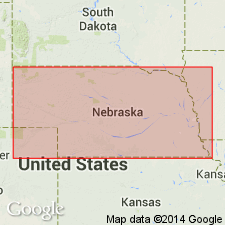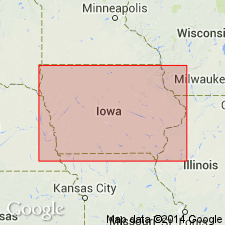
- Usage in publication:
-
- Dry shale
- Modifications:
-
- Original reference
- AAPG geologic province:
-
- Forest City basin
Summary:
Pg. 22, 236, etc. Dry shale of Wabaunsee group. Dry shale is here applied to shaly beds, 5 to 20 feet or more thick, that separate Dover limestone from next higher (Grandhaven) limestone. Is bluish gray and for most part clayey, but sandy beds appear in places. In southern Kansas a thin coal occurs near top. Is well-defined unit from Shawnee County, eastern Kansas, south to Oklahoma line, but to north it coalesces with Friedrich shale above and Grandhaven limestone, which disappears, although it is possible the Grandhaven beds grade laterally into the shale. Where the shale between Dover and Jim Creek limestone cannot be subdivided it may be called [/]Dry-Friedrich shale. Age is Late Pennsylvanian (Virgil).
Type locality: Dry creek, southwest of Emporia, in sec. 5, T. 20 S., R. 11 E., [Lyon Co.], eastern KS.
[GNC remark (ca. 1936, US geologic names lexicon, USGS Bull. 896, p. 635): This name appears to have first appeared in print, without definition, in a table by R.C. Moore published opp. P. 14 of Univ. Kansas Bull., no. 20, May 1, 1935.]
[The use of a hyphen between undifferentiated formations is not considered proper notation (CSN, 1933).]
Source: US geologic names lexicon (USGS Bull. 896, p. 634-635); GNC KS-NE Pennsylvanian Corr. Chart, sheet 2, Oct. 1936.

- Usage in publication:
-
- Dry shale
- Modifications:
-
- Areal extent
Summary:
Pg. 15. Dry shale. Consists of clay-shale, sandy shale, and fossilfierous lime seams. Thickness 14 feet in clay pits at Nebraska City. Age is Late Pennsylvanian (Virgilian). Areal extent noted.
Source: US geologic names lexicon (USGS Bull. 1200, p. 1161-1162).

- Usage in publication:
-
- Dry shale member*
- Modifications:
-
- Revised
Summary:
Pg. 2274 (fig. 1), 2275. Dry shale member of Stotler limestone. Rank reduced to member status in Stotler limestone (new). Underlies Grandhaven limestone member; overlies Dover limestone member. Age is Late Pennsylvanian (Virgilian).
Source: US geologic names lexicon (USGS Bull. 1200, p. 1161-1162).

- Usage in publication:
-
- Dry shale
- Modifications:
-
- Areal extent
Summary:
Pg. 12, fig. 5. Dry shale of Wabaunsee group. Bluish-gray silty shale with thin interbedded gray limestone and siltstone; ferruginous concretions common in siltstone. Thickness about 20 feet. Underlies Grandhaven limestone; overlies Dover limestone. Age is Late Pennsylvanian (Virgilian).
Source: US geologic names lexicon (USGS Bull. 1200, p. 1161-1162).
For more information, please contact Nancy Stamm, Geologic Names Committee Secretary.
Asterisk (*) indicates published by U.S. Geological Survey authors.
"No current usage" (†) implies that a name has been abandoned or has fallen into disuse. Former usage and, if known, replacement name given in parentheses ( ).
Slash (/) indicates name conflicts with nomenclatural guidelines (CSN, 1933; ACSN, 1961, 1970; NACSN, 1983, 2005, 2021). May be explained within brackets ([ ]).

